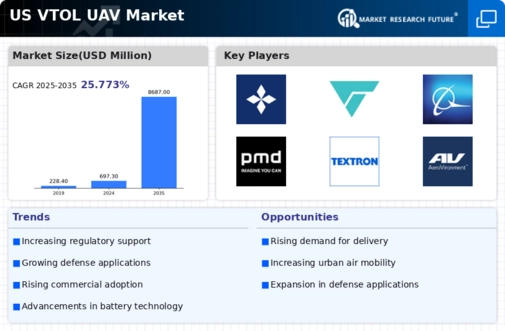Advancements in Battery Technology
Battery technology advancements are playing a crucial role in shaping the vtol uav market. The development of more efficient and lightweight batteries is enabling longer flight times and greater payload capacities for drones. Recent innovations have led to batteries that can provide up to 50% more energy density compared to previous generations. This improvement is particularly significant for commercial applications, where extended operational range is essential. As battery technology continues to evolve, it is likely to enhance the performance and reliability of vtol uavs, making them more appealing to various industries. The increased efficiency of battery systems may also lead to lower operational costs, further driving adoption in the vtol uav market. Consequently, stakeholders in the industry are closely monitoring these advancements to leverage their potential benefits.
Increased Demand for Delivery Services
The vtol uav market is experiencing a notable surge in demand for delivery services, particularly in urban areas. This trend is driven by the growing need for efficient logistics solutions, as consumers increasingly expect rapid delivery times. According to recent estimates, the e-commerce sector in the US is projected to reach $1 trillion by 2025, which could significantly boost the vtol uav market. Companies are exploring the use of drones for last-mile delivery, which is often the most costly and time-consuming segment of the logistics chain. As a result, investments in vtol uav technology are likely to increase, with businesses seeking to enhance operational efficiency and reduce costs. This heightened demand for delivery services is expected to propel the vtol uav market forward, creating new opportunities for manufacturers and service providers.
Growing Interest in Surveillance and Monitoring
The vtol uav market is witnessing a growing interest in surveillance and monitoring applications across various sectors, including agriculture, law enforcement, and environmental monitoring. The ability of vtol uavs to provide real-time data and aerial imagery is becoming increasingly valuable for decision-making processes. For instance, agricultural producers are utilizing drones for crop monitoring, which can lead to yield improvements of up to 20%. Similarly, law enforcement agencies are adopting vtol uavs for enhanced situational awareness during operations. This trend is likely to drive investment in vtol uav technology, as organizations seek to capitalize on the benefits of aerial surveillance. The increasing demand for data-driven insights is expected to further propel the vtol uav market, as more industries recognize the advantages of integrating drone technology into their operations.
Increased Investment in Research and Development
Investment in research and development (R&D) is a key driver of growth in the vtol uav market. Companies are allocating substantial resources to innovate and enhance drone technologies, focusing on improving flight capabilities, safety features, and operational efficiency. Recent data suggests that R&D spending in the aerospace sector is expected to reach $20 billion by 2026, with a significant portion directed towards vtol uav advancements. This influx of funding is likely to accelerate the development of new technologies, such as autonomous flight systems and advanced navigation solutions. As the industry evolves, the emphasis on R&D will be crucial for maintaining competitive advantages and meeting the diverse needs of end-users. Consequently, the vtol uav market stands to benefit from these investments, fostering a culture of innovation and technological progress.
Emerging Applications in Infrastructure Inspection
The vtol uav market is expanding due to emerging applications in infrastructure inspection. Drones are increasingly being utilized for inspecting bridges, power lines, and pipelines, offering a safer and more efficient alternative to traditional methods. The ability to conduct inspections without the need for scaffolding or extensive manual labor can reduce costs and improve safety outcomes. According to industry reports, the infrastructure inspection market is projected to grow at a CAGR of 15% over the next five years, which could significantly benefit the vtol uav market. As regulatory bodies emphasize the importance of regular inspections to ensure safety and compliance, the demand for vtol uavs in this sector is likely to rise. This trend indicates a promising future for the vtol uav market as it aligns with the growing need for innovative solutions in infrastructure management.






















Leave a Comment